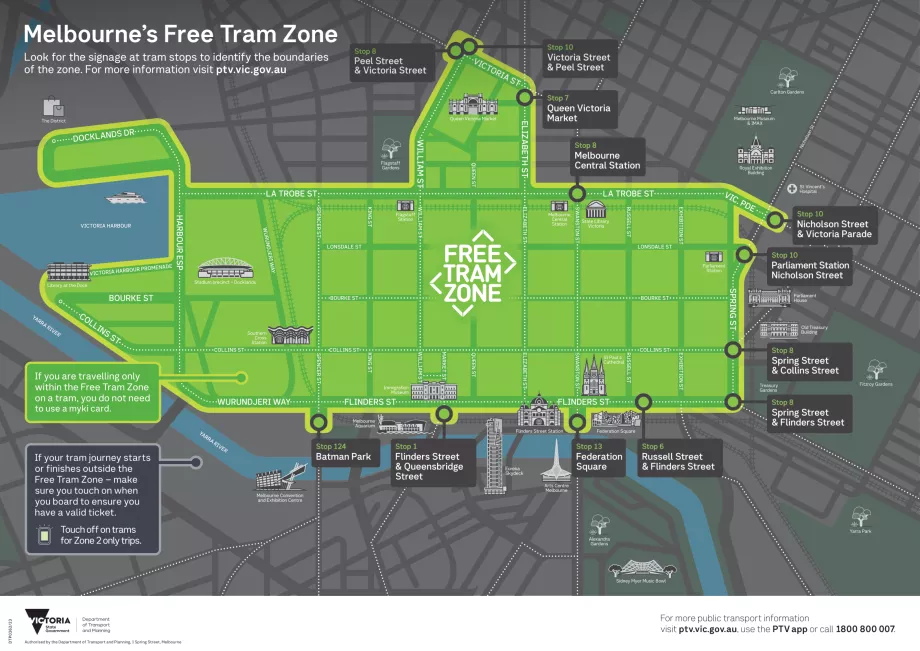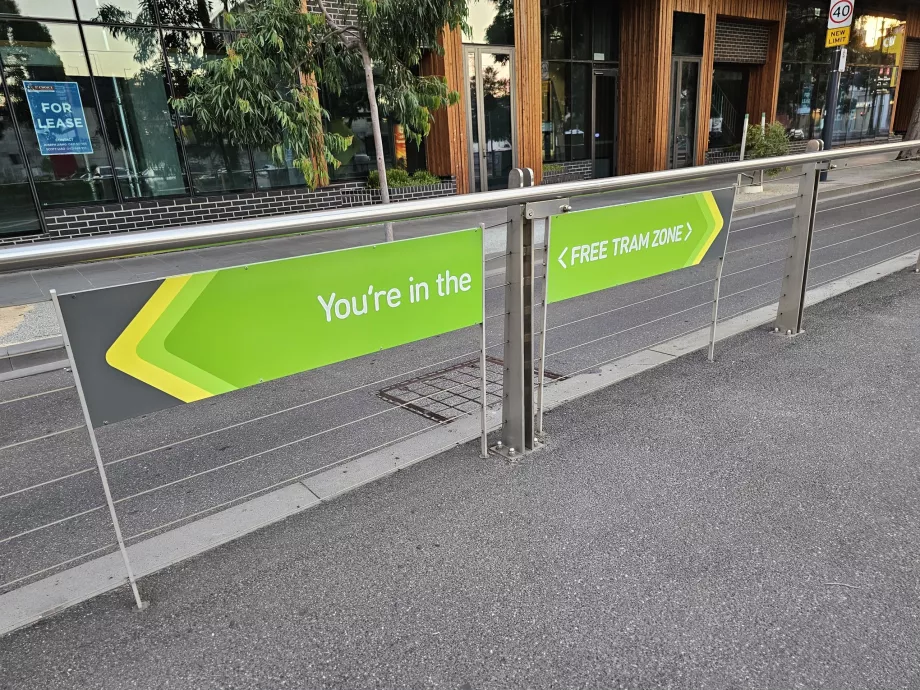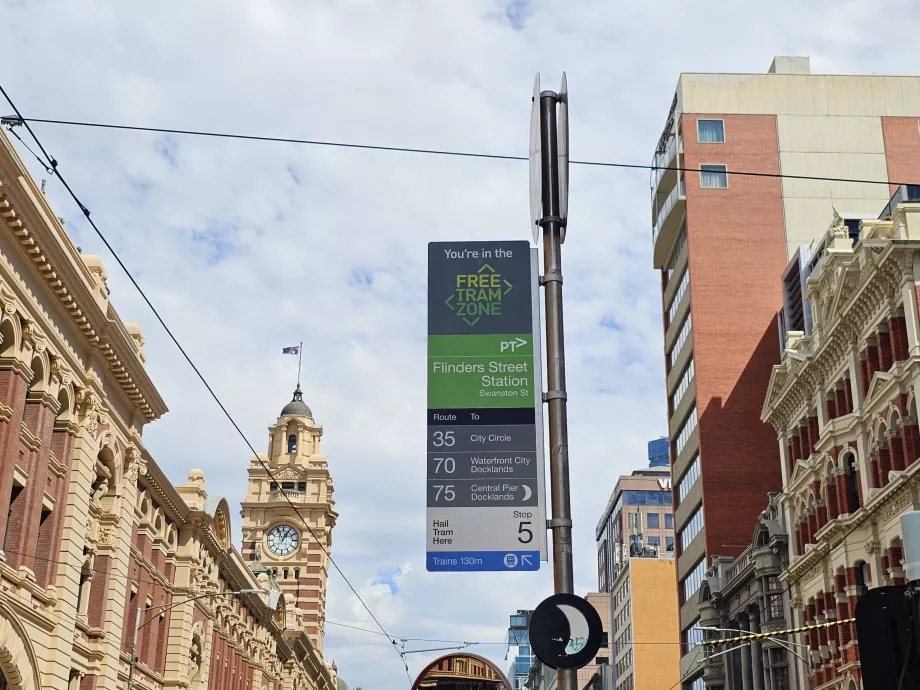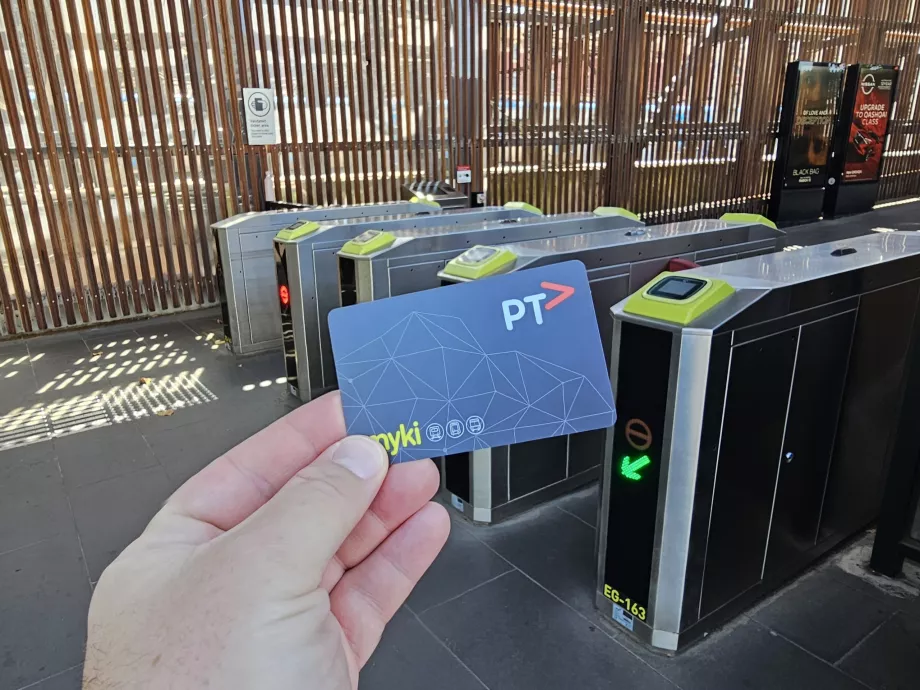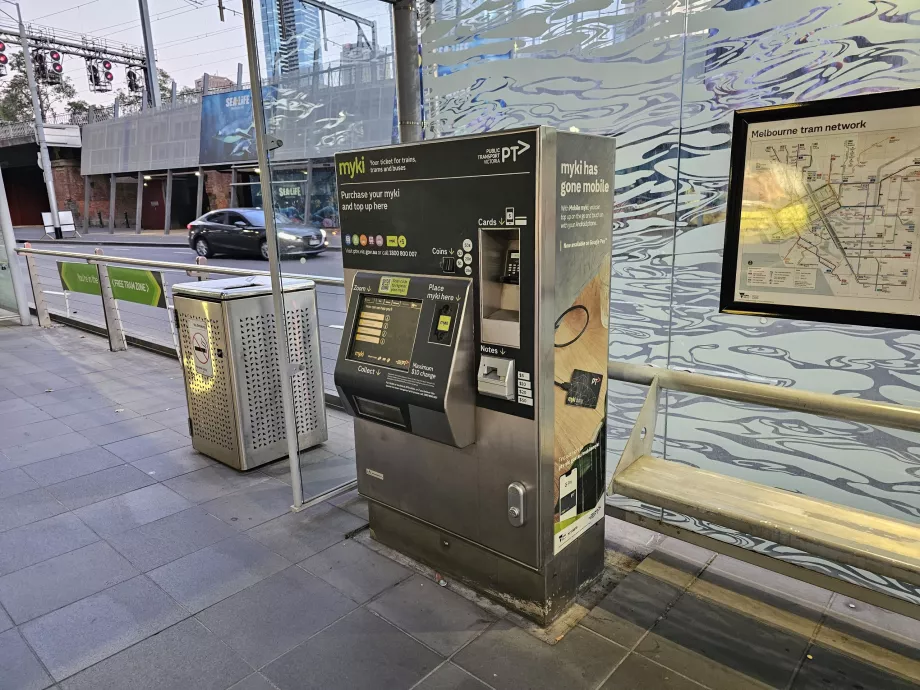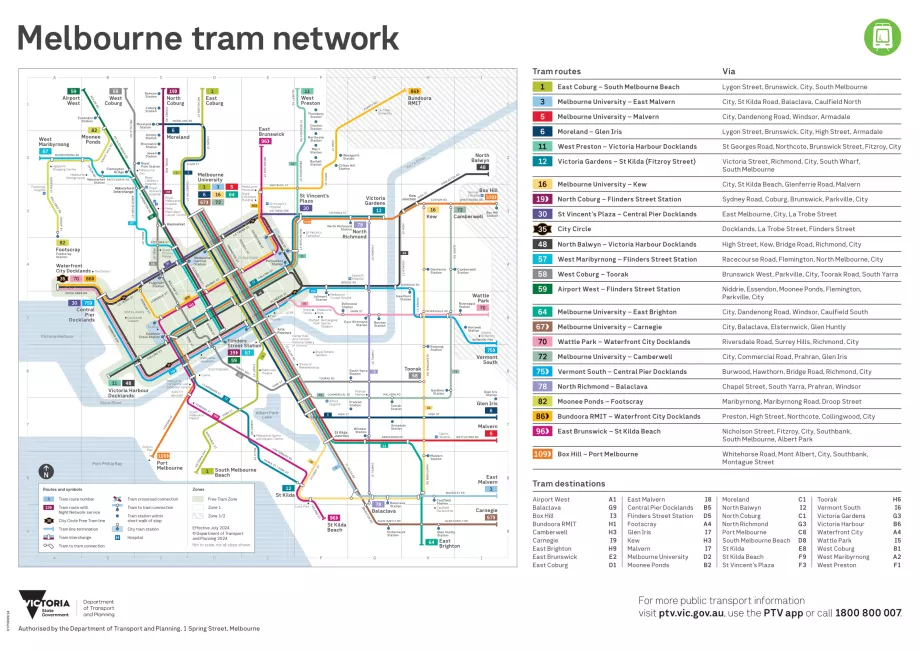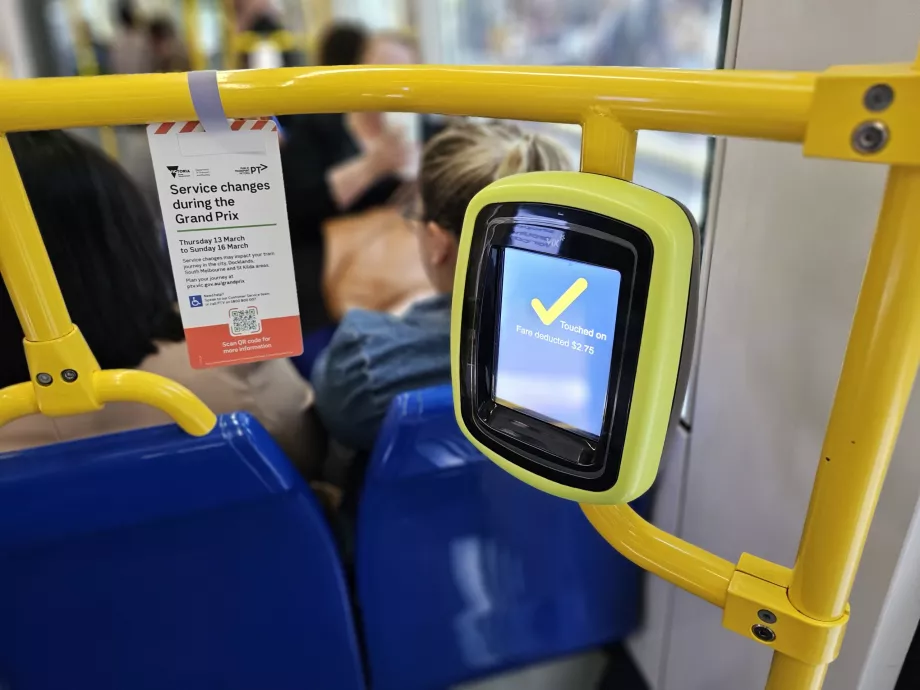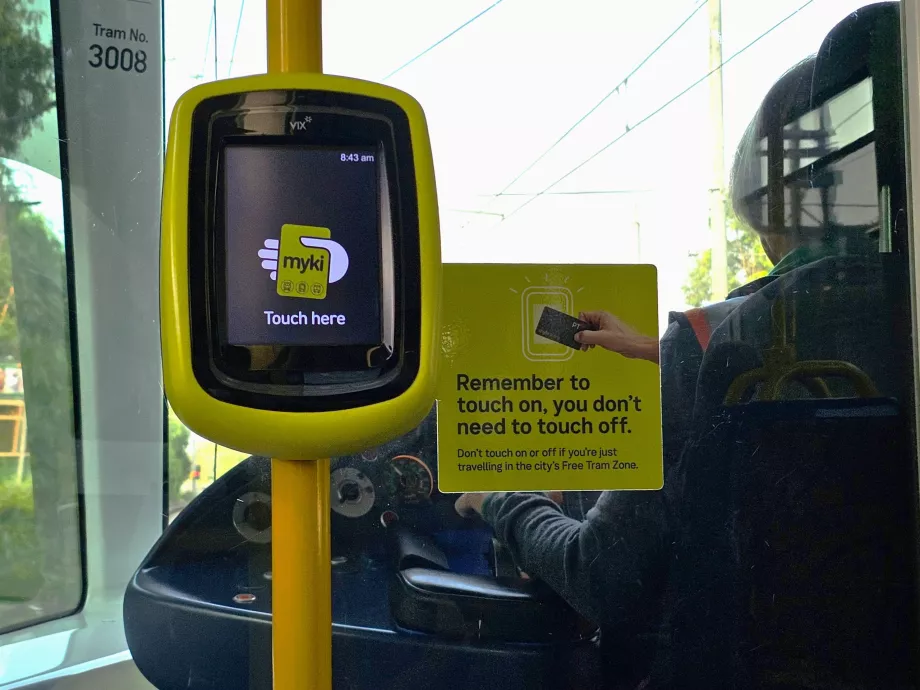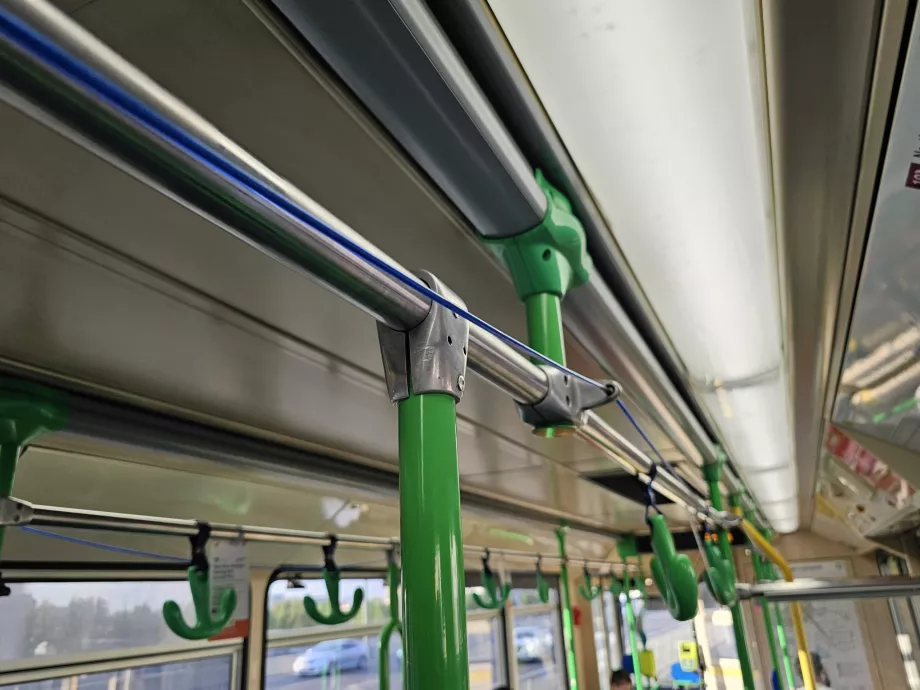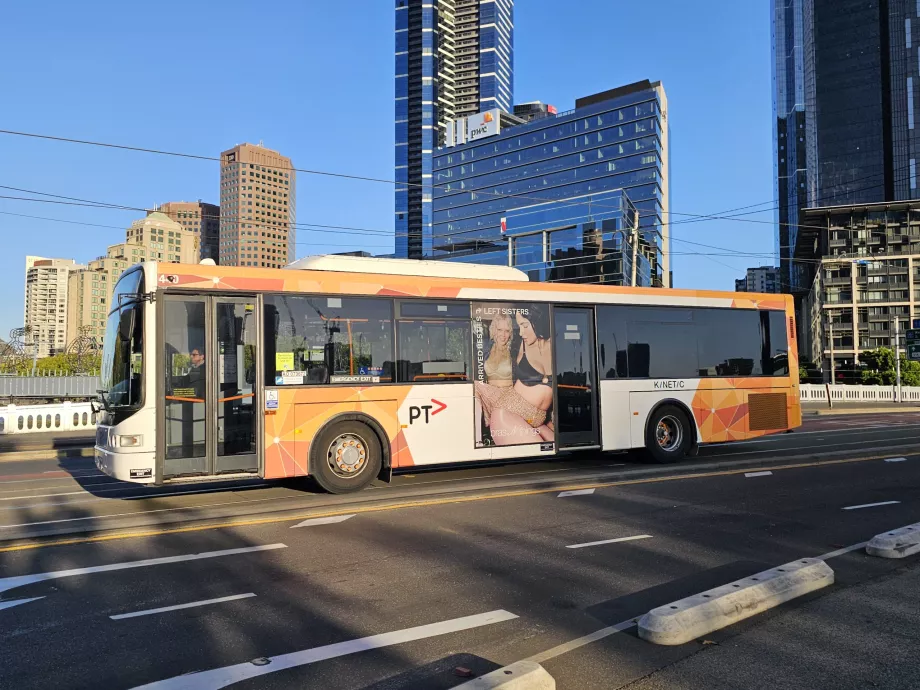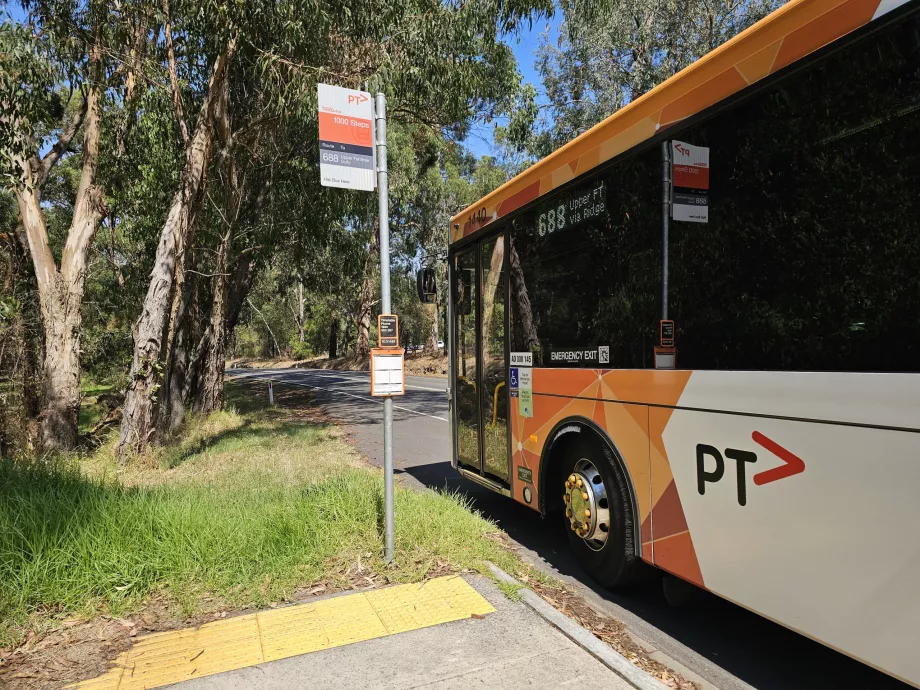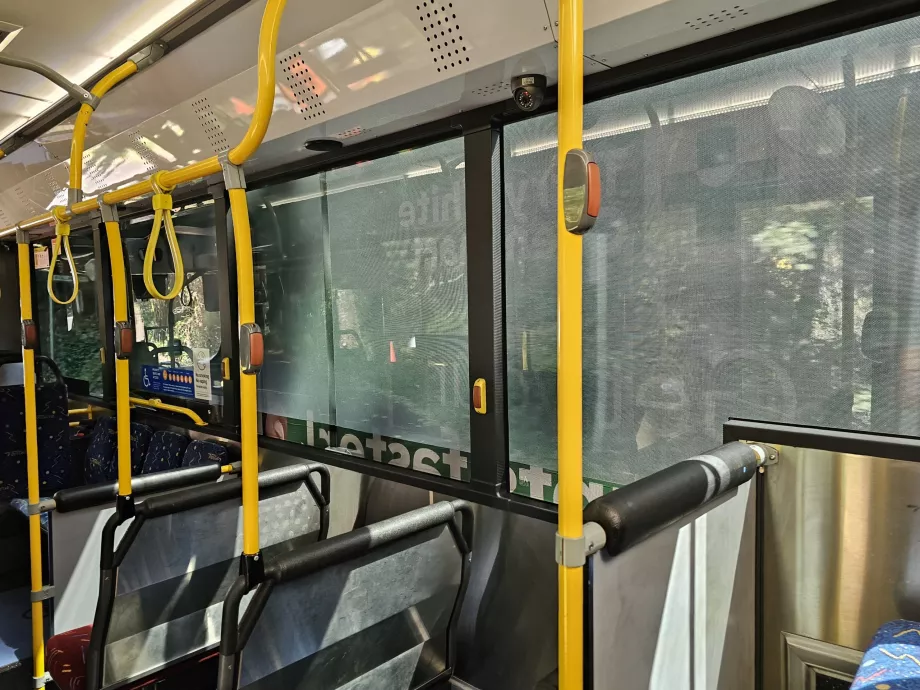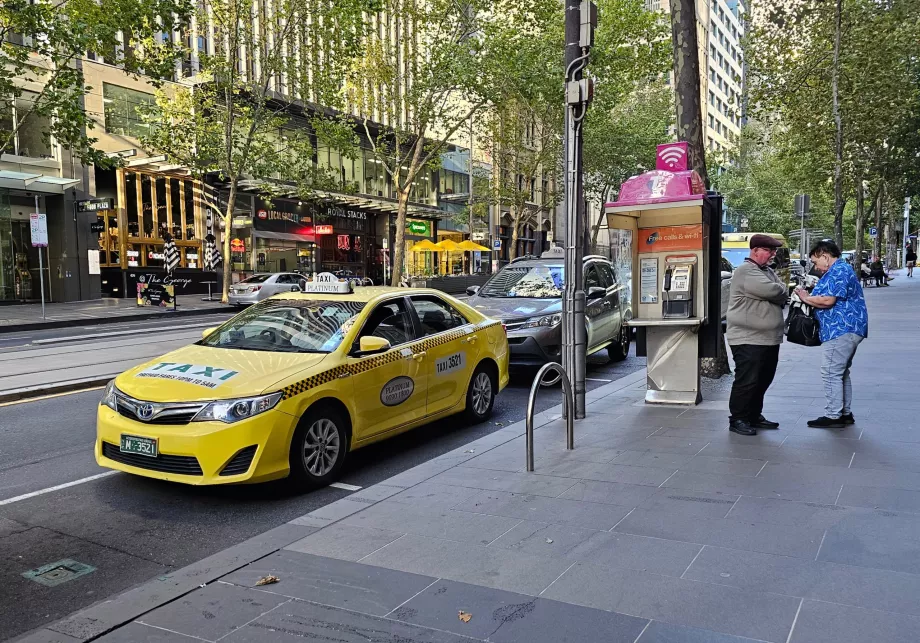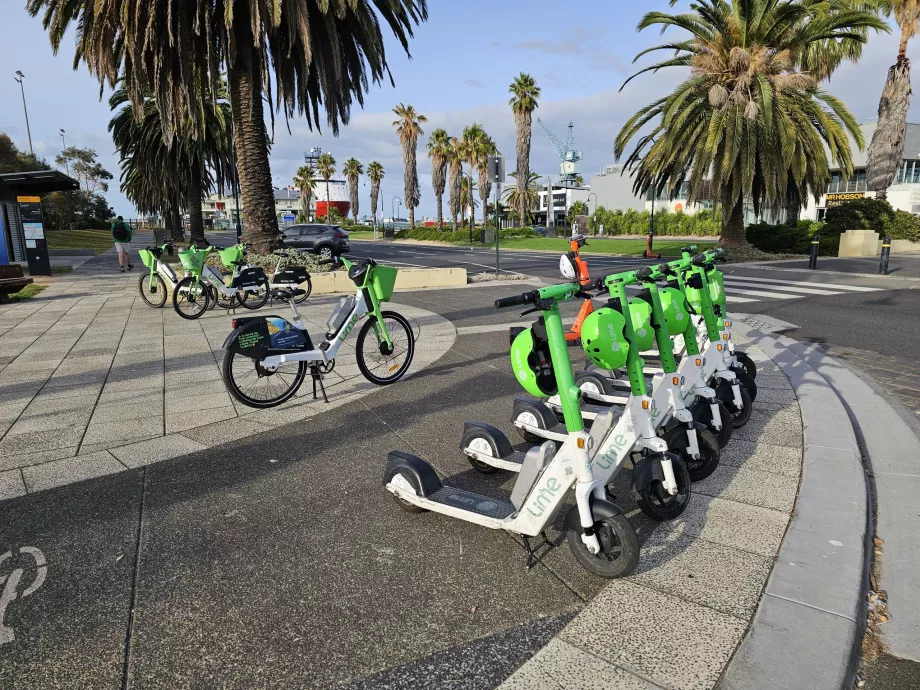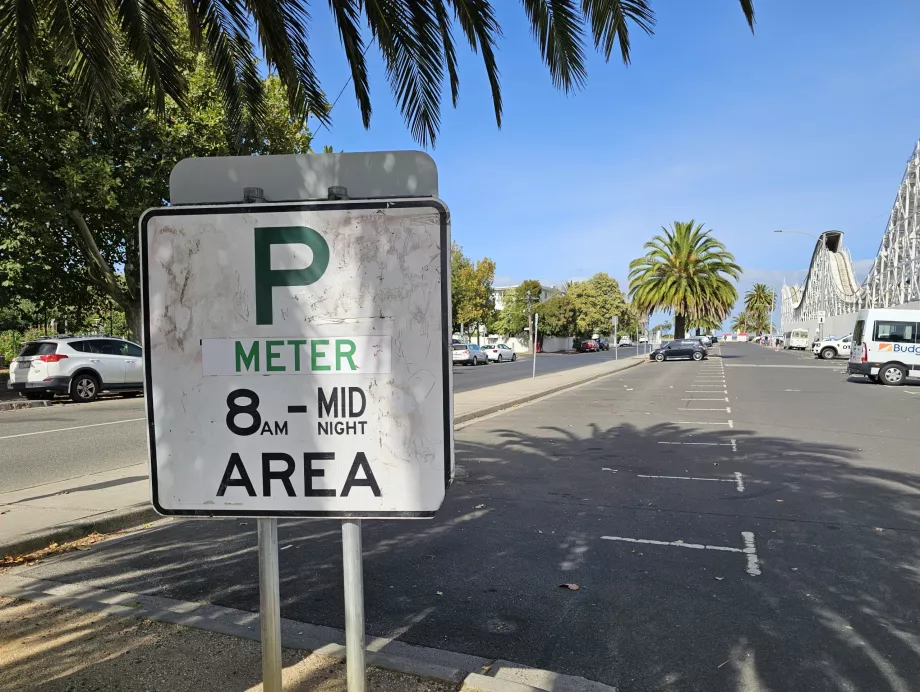Getting around Melbourne
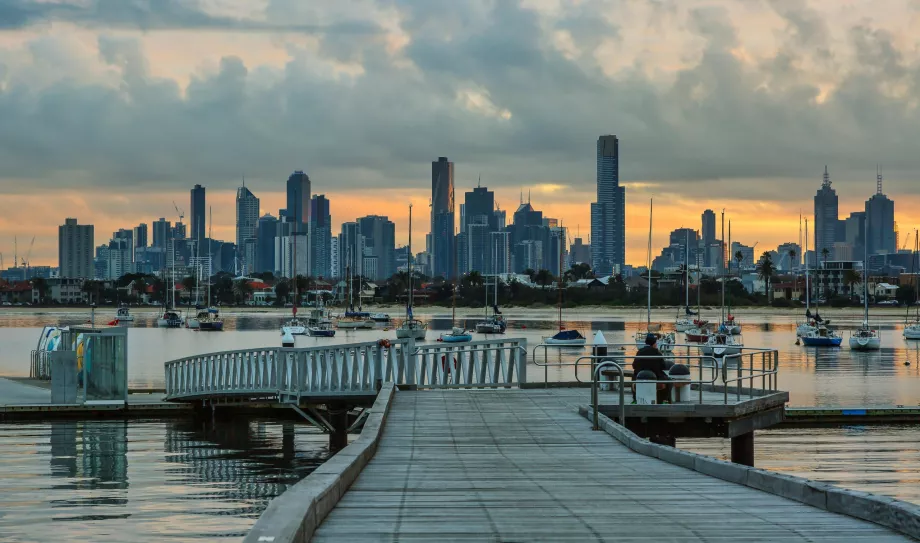
Melbourne is a large city, but with a fairly compact centre, so many of the sights can be explored on foot during the day. However, you probably won't be able to avoid public transport to get to the beaches or national parks anyway.
Book a hotel in central Melbourne
Public transport in Melbourne is provided by Public Transport Victoria (PTV)which operates the city's trains (metro), trams and buses.
For details, visit the official website ptv.vic.gov.au.
Tickets and prices
In Melbourne, there is a single myki fare for all modes of transport - trams, PTV buses, city trains/metros and V/Line trains within zones 1 + 2.
Free Tram Zone - Free Tram Zone
Within the Central Business District, the central part of Melbourne, you'll ride the tram for free!
The entire downtown and Docklands area is part of this zone and if you travel by tram only within the Free Tram Zone, you pay no fare. So you won't need to attach your Myki card (or your own contactless card in the future) to the reader at all.
If you start your journey in the Free Tram Zone and enter outside it or vice versa, you pay the standard fare.
This zone also applies to the historic tram line 35, which does not leave its boundaries at all. Therefore, there is no fare to ride the historic tram either.
The Free Tram Zone only applies to trams! If you use the metro/train or buses in this area, you must pay the standard fare.
Other zones
The fares are broken down by zone, but realistically you don't have to deal with them at all as a passenger. The system will automatically calculate the price itself according to what is most convenient for the passenger.
Melbourne is divided into zones 1 and 2.
The base fare of $5.50 applies to any journey within Zone 1 or when transferring between Zones 1 + 2. If you only travel within Zone 2, the fare is cheaper.
However, Zone 2 only extends to the outskirts of Melbourne.
Fares
Public transport tickets in Melbourne are relatively cheap and the fare system is very clear.
- 5,50 aud - 2 hours (any number of transfers), for journeys in Zone 1 or 1+2
- 11 aud - weekday daily cap, calculated by calendar day, not 24 hours after the first journey
- 7,60 aud - maximum daily fare at weekends and on public holidays, calculated according to the calendar day, not 24 hours after the first journey
- 55 aud - 7-day pass
If you only travel in Zone 2 (the full outskirts of Melbourne), you will pay 3,50 aud for a 2-hour pass. You will virtually never use the all-day or 7-day pass for Zone 2 only as a tourist.
For a detailed and up-to-date fare schedule, visit the official website: ptv.vic.gov.au/fares/metropolitan-fare.
Discounted fares for children and seniors
The following categories of passengers can take advantage of the cheaper fares, called Concession, at 50% of the normal fare:
- Children aged 5 to 18 years (including international visitors)
- Seniors (permanent residents of Australia only)
Children under 5 years travel free in Melbourne.
How to pay fares - myki card
Currently to pay fares you need to purchase a myki card for 6 aud or pay via Google Pay. Mobile payment is currently only available for Android phones and not for iPhones.
When purchasing a myki card, you must choose between two options:
- myki Money - you load any amount of money onto the card, which is gradually charged according to the tariffs listed above
- myki Pass - you can load a 7-day or annual pass onto the card
You can reload your myki Money card at any time.
- Tram - you only need to attach the card to the validator inside the carriage when boarding. Many passengers (including locals) also attach the card when getting off the tram, but in this case they run the risk of miscalculating the fare. It is explicitly stated directly in the trams and on the official website that you only "beep" when boarding the tram. If you travel only within the Free Tram Zone, you do not attach the card to the validator even when boarding.
- Trains/metros - you attach the card to the turnstile or validator when entering and leaving the station.
- Buses - you attach the card to the validator inside the carriage on boarding and alighting.
Detailed information is available on this page: ptv.vic.gov.au/travel-with-myki.
Where can I buy and top up my myki card?
Myki can be purchased at a number of locations:
- Vending machines at some tram stops and at all train/metro stations - you can pay by credit card and cash.
- All 7-Eleven stores
- At the PTV Information Centre at Southern Cross station
In contrast, you cannot buy a physical myki card at Melbourne Airport.
You can top up your physical card at the locations mentioned above, plus via the PTV mobile app.
How do I pay by mobile?
If you don't want to use a physical myki card, you can pay via your phone and save 6 aud on card issuance.
Currently, payment is only possible via Google Wallet, i.e. only for Android mobile phone users and not Apple.
The mobile phone must be equipped with NFC technology and when attaching the mobile phone to the validator, always make sure that you have selected the myki card for the current payment.
Detailed information on paying with your phone can be found here: ptv.vic.gov.au//mobile-myki.
Can I pay with my own contactless card?
This option is not currently available in Melbourne and is expected to be launched in 2026.
Can I pay my fare in cash?
No. You must purchase and top up a myki card to pay your fare (this can also be done in cash).
Trams in Melbourne
Trams are the primary means of transport for getting around downtown, to the Docklands or to the nearby beaches of St. Kilda or Port Melbourne.
Melbourne has the most extensive tram network in the world in terms of kilometres of track.
Tram services are very frequent and individual lines run at a frequency of 5 to 8 minutes on weekdays and 7 to 12 minutes on weekends.
Useful tram lines
Tourists most often use the following tram routes:
- From Southern Cross station
- Lines 89, 96 towards the centre along Bourke Street and the Royal Exhibition Building.
- Lines 11, 12, 109 towards the centre along Collins Street, Parliament, Fitzroy Gardens and St Patrick's Cathedral
- Lines 12, 96 towards Albert Park and St. Kilda
- Line 109 towards Port of Melbourne and north end of South Melbourne Beach
- From Filnders Street station
- Lines 3, 5, 6, 16, 64, 67, 72 towards Shrine of Remembrance and Royal Botanic Gardens Victoria
- Lines 35, 70, 75 towards Docklands
- Line 16 towards St. Kilda
- Line 1 towards the middle part of South Melbourne Beach
- Line 75 towards Fitzroy Gardens
- From Melbourne Central station
- Lines 3, 5, 6, 16, 64, 67, 72 towards Shrine of Remembrance and Royal Botanic Gardens Victoria
- Line 30 towards Docklands and Royal Botanic Gardens Victoria
- Line 16 towards St. Kilda
- Line 1 towards the middle part of South Melbourne Beach
A pdf map of all tram routes can be found on the official website: ptv.vic.gov.au/maps.
Timetables and operating hours
Individual routes generally run from 5:30am to 12:30am on weekdays and Saturdays, or from 7:30am on Sundays.
On Friday to Saturday and Saturday to Sunday nights, service is extended until approximately 2am.
Full timetable information can be found at ptv.vic.gov.au/timetables.
How do I pay my fare?
If you only travel within the Free Tram Zone in the city centre (see map and information above), you pay no fare.
Otherwise, when you board the tram, you attach your myki card to the validator at each door.
When you get off the tram, you do not attach the card anymore!
Stops on request
All tram stops are on request.
If you are standing at a tram stop, wave to the arriving tram to stop.
To get off, press the red stop button or, on older trams, pull the blue string.
City trains / metro
Although Melbourne does not have a conventional metro network, it is effectively replaced by a dense network of city trains.
In the central sections, trains are frequented in a similar way to the subway and often run underground within the city centre.
However, even given the relatively small size of the central area, trains will be used mainly for travel to the suburbs, and tourists will travel by train mainly to more distant beaches or national parks.
Detailed information on trains is given in a separate chapter on the Melbourne Metro.
The 10 best hotels in Melbourne
Buses
Bus services are mainly concentrated on the outskirts of Melbourne and are not very useful for tourists.
Bus routes are shown on maps of each metropolitan area: ptv.vic.gov.au/metropolitan-local-area-maps.
For example, use bus route 688 to get to Dandenong Ranges National Park.
Tourists also use Line 901 running from Broadmeadows City Train Station to Melbourne Airport to save on the expensive direct SkyBus.
Timetables and operating hours
Individual routes usually run from 5:30am to 12:30am on weekdays and Saturdays, or from 7:30am on Sundays.
Buses usually run at a frequency of around 10-15 minutes in the central part of the city, but often run only 1-2 times per hour in the outskirts.
At night from Friday to Saturday and Saturday to Sunday the service is extended until around 2:00 am.
Full timetable information can be found at ptv.vic.gov.au/timetables.
How do I pay my fare?
Attach your myki card to the reader on boarding and alighting.
You can board through all doors.
Stops on request
All bus stops are on demand.
If you are standing at a bus stop, wave to the arriving bus to stop.
To get off, press the red stop button.
Taxi, Uber, Bolt
There are many taxis plying Melbourne's streets, but there are relatively few outside the city centre and you can't rely on a taxi to stop you by waving on the street.
Taxis usually wait outside large hotels or major transport hubs.
A city ordinance sets maximum fares:
- The starting rate between 9:00 and 17:00 is 5,10 aud
- The starting rate between 17:00 and 09:00 is 6,35 aud (even on Friday and Saturday nights 7,60 aud)
- 1 km of driving (if the speed is higher than 21 km/h) is from 1,982 aud to 2,426 aud
- 1 minute of driving (if the speed is below 21 km/h) is from 0,694 aud to 0,849 aud
Fares can always be paid by card or cash.
Alternative taxi services such as Uber also work well in Melbourne and usually have lower prices than traditional taxis. Download the app and hail a car anytime, anywhere:
- Uber (Appstore / Google Play)
Uber's availability is significantly better than that of regular taxis.
Bike share app
A good alternative for getting around the city besides walking and public transport is a bike.
A big advantage in this regard is the fact that Melbourne is a relatively flat city and the cycling infrastructure is of a decent standard.
We wouldn't recommend cycling too much in the city centre where there are no separate cycle lanes, but along the coast and in the suburbs, a bike or scooter is often the quickest mode of transport.
There is currently one major bike and scooter sharing app , Lime.
Parking in Melbourne
If you're going to rent a car in Melbourne, it's recommended that you do so on the day you're leaving the city for a road-trip along the Great Ocean Road, for example.
Driving a car in Melbourne isn't that difficult though, as the streets are wide and the traffic isn't as nerve-wracking. However, it is often difficult for visitors to navigate the one-way street system and the directional signage within the city is not very good.
In addition, Melbourne's public transport system is one of the best in the world, so you won't need a car to get around the city purely.
Still, if you do drive around Melbourne, you'll probably be mainly concerned with parking.
Street parking and parking lots along the beaches usually charge a fee, even outside the city centre.
You can only ever pay cashless, most easily via the EasyPark mobile app.
Parking rates vary by location from 4 aud to 7 aud per hour, and outside the centre there is usually a maximum daily rate of around 10 aud.
For detailed parking information, visit the city's official website: melbourne.vic.gov.au/where-to-park.
Any questions left?
If you have any questions or comments about the article...

